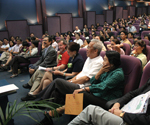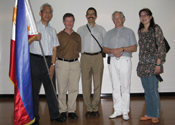|
|
Vol. 30 No. 4
July-August 2008
Improving Chemical Education in the Philippines
by Fortunato B. Sevilla III
 |
| Peter Mahaffy (red shirt), chair of the IUPAC Committee on Chemistry Education, and others listen to a lecture. |
A two-day conference on Improving Chemical Education in the Philippines was held at the University of Santo Tomas in Manila, Philippines, from 17–18 April 2008. The conference was a project of the IUPAC Flying Chemists Program and was organized by the Commission on Higher Education (CHED), the government body covering higher education institutions in the Philippines, in cooperation with the Kapisanang Kimika ng Pilipinas (Chemical Society of the Philippines) and the University of Santo Tomas.
This conference is a follow-up activity to the revision carried out by the CHED Technical Committee for Chemistry of the curriculum for the B.S. program for chemistry. It aimed to upgrade the course delivery methods employed by chemistry teachers in the Philippines. The project was inspired by the write-ups featured in Chemistry International on the Indian and Sri Lanka projects of the Flying Chemists Program <www.iupac.org/standing/cce/FCP.html>.
Participation in the conference, a total of 324 tertiary-level chemistry teachers, was beyond expectations. Attendees came from all the regions of the country and represented 89 different institutions of higher education in the Philippines. Among the participants were 12 young chemistry teachers who received travel grants through the IUPAC Program on Financial Support of Conferences.
Five lectures were presented during the conference by IUPAC affiliated experts:
- “The Role of Visualization” by Peter Atkins of Oxford University, UK
- “New Technologies and New Tools for Chemistry Education” by Peter Mahaffy of King’s University College, Canada
- “Microscale Chemistry” by Jorge G. Ibañez of the Universidad Ibero-Americana, Mexico
- “Evaluation of an Integrated Chemistry Laboratory Program at the Undergraduate Level in Taiwan” by Mei-Hung Chiu of the National Taiwan Normal University, Taiwan
- “Low-Cost Instrumentation for Chemical Education” by Fortunato Sevilla III of the University of Santo Tomas, Philippines
Peter Atkins demonstrated how pictures can help with simple introductory chemistry issues, such as stoichiometry and electrochemistry. Peter Mahaffy presented approaches that he has found valuable in introductory university chemistry, and gave examples of new tools for helping students to visualize the molecular world. Jorge Ibanez proved that the majority of the laboratory experiences in chemistry can be substituted using small-scale techniques without decreasing the educational gain. Fortunato Sevilla III discussed instrumentation that can be fabricated at low cost and that can be used for microscale experiments. Mei-Hung Chiu reported on the impact of a integrated laboratory program for students at the National Taiwan University. The program uses a scaffolding structure to integrate different skills for conducting chemistry experiments needed for developing chemistry literacy.
Three workshops were conducted concurrently in two sessions of the conference. The topics of the workshops were “Visualizing Chemistry,” “Low-Cost Instrumentation,” and “Microscale Chemistry,” which were facilitated by Peter Mahaffy, Fortunato Sevilla, and Jorge Ibañez, respectively. These workshops provided the participants with a hands-on and up-close experience with the teaching and learning resources described in the lectures. An industry-academe forum was also held, involving three presentors.
The conference opened with welcoming remarks from Fortunato Sevilla III, chair of the CHED Technical Committee for Chemistry and dean of the UST College of Science; Saturnino Ocampo Jr., CHED commissioner; and Peter Mahaffy, chair of the IUPAC Committee for Chemistry Education.
 |
| The five IUPAC lecturers, from left : Fortunato Sevilla, Peter Mahaffy, Jorge Ibañez, Peter Atkins, and Mei-Hung Chiu. |
The culmination of the conference was the presentation of the output of the parallel group discussions, wherein the participants evaluated the applicability of the approaches or strategies presented in the five lectures. The participants affirmed that visualization, microscale laboratory experiments, low-cost instrumentation, and integrated laboratory courses can be implemented in various courses in the B.S. chemistry program offered by colleges and universities in the country. They expressed enthusiasm in carrying out the newly learned approaches and adopting newly learned technologies to improve the teaching and the learning of chemistry.
The output of these discussions provided the basis for the actions that will be taken to improve chemistry education. The outcome of these actions will be reported during the 2009 Philippine Chemistry Congress, wherein several sessions will focus on chemistry education. The participants agreed to present papers during the congress on their endeavors to apply the tools and strategies expounded by the IUPAC speakers. Indeed, the IUPAC “flying chemists” have become partners of the Philippine chemistry teachers in their goal to upgrade chemical education in the Philippines.
Fortunato
Sevilla <[email protected]>
is a professor at the University of Santo Tomas, Department
of Chemistry, Manila, Philippines. He chaired this activity
under the IUPAC Flying Chemist Program, IUPAC project
2007-018-1-050.
Page
last modified 8 August 2008.
Copyright © 2003-2008 International Union of Pure and
Applied Chemistry.
Questions regarding the website, please contact [email protected]
|